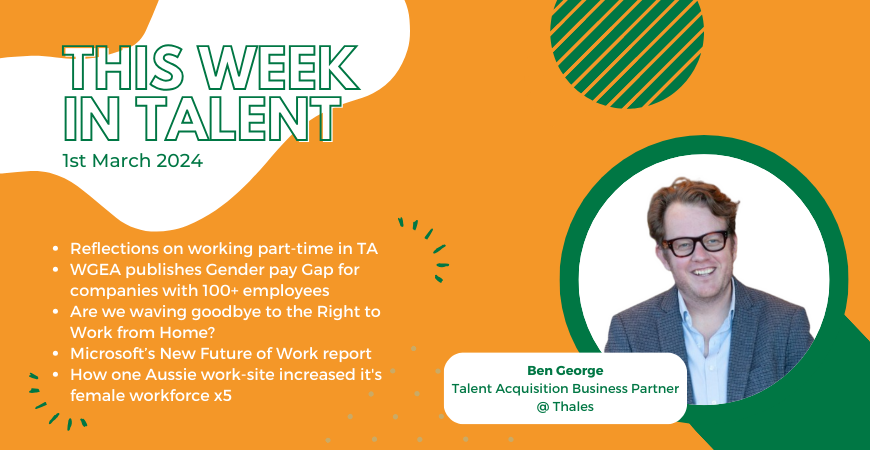In March 2023, we asked Talent Leaders from 230 leading companies around Australia & New Zealand how they felt about the fairness of the pay structure in their organisation.
When asked to rate out of 10 if their ‘Organisation has “robust remuneration practices that ensure all people are paid fairly and equitably”, 63% of respondents rated themselves a 7/10 or higher.
However, when asked in a follow up question about their gender pay gap, only 38% said that they and their Manager knew their company’s Gender Pay Gap without looking it up.
The data reveals a significant discrepancy between respondents’ perceptions of their organisation’s commitment to fair and equitable pay practices and their actual knowledge of the gender pay gap within their company by those that are responsible for making salary offers.
In our follow up interviews with Talent Leaders who took part in the survey, the role of Job Architecture in ensuring fair pay practices became apparent.
“Even as Global Head of TA, I don’t have access to our Gender Pay Gap so I’m all for the new transparency legislation as Rem & Benefits who have the data will have to show it.”
“Salary demand from the external market is 30-50% higher than internal salaries. If we closed the pay gap, we’d need to adjust all of our internal staff which at that rate is unaffordable. Our staff are saying that it’s actually better for them to leave and then come back so they can negotiate a better salary.”
“Our process is to ask all candidates what their current salary is as well as what their expectations are to avoid offering candidates large increases to move across. I have tried hard to influence but have been unable to shift old mindsets.”
What is Job Architecture?
Job Architecture refers to the systematic and structured approach of designing and organising job roles, hierarchies, and career paths within an organisation. Job Architecture provides the foundation for equitable and transparent compensation systems by considering factors such as job responsibilities, skills, qualifications, and market value.
Job Architecture serves as the backbone for remuneration and fair pay practices. It establishes consistent job evaluation processes, supports pay equity, promotes internal equity and transparency, and ensures market competitiveness.
By leveraging job architecture effectively, organisations can foster fair and equitable compensation systems that align with the value and responsibilities of each job role.
When interviewing Talent Leaders for our 2023 State of Talent Acquisition Report, here’s what one talent leader told us about job architecture:
“The job architecture work that the HR team did has been invaluable, it benefits us in multiple ways including avoiding pay gaps, overall hiring equity, learning and development pathways and internal promotions. We have three job families, each with several streams, and every role is structured around four core competencies. It becomes much simpler to map a candidate and their capabilities to a role, and from that know what is a fair and equitable offer regardless of their gender or even years of experience. Everything starts with the job architecture model.”
5 ways job architecture impacts the gender and diverse pay gap
- Job Evaluation
Job architecture helps establish a consistent and objective job evaluation process. This process assesses the relative value of different jobs within the organisation based on factors such as job complexity, skills required, and level of responsibility. These results inform decisions about job grading and pay structures.
- Pay Equity
Job architecture supports pay equity by defining clear job levels and salary ranges. It helps determine appropriate compensation benchmarks for each job level, considering factors like market rates and internal pay equity.
- Internal Equity
Job architecture enables organisations to establish internal equity by defining clear career progression paths and opportunities for advancement. It provides a framework for employees to understand how their roles fit within the organisation and the potential for growth. Employees with similar job levels and responsibilities can be compensated consistently, ensuring fairness and reducing disparities.
- Transparency & Communication
Job architecture facilitates transparency in remuneration practices. Clearly defined job levels, pay ranges, and career paths allow employees to understand how their compensation is determined and how they can progress within the organisation. Transparent communication about the job architecture and its link to compensation fosters trust and confidence among employees regarding the fairness of pay decisions.
- Market Competitiveness
Job architecture helps organisations assess their market competitiveness in terms of pay. By aligning job levels and corresponding salary ranges with market data, organisations can ensure that their compensation practices are competitive and attractive to potential candidates. This helps attract and retain talent while maintaining fair pay practices within the industry.
This article is an extract from the 2023 State of Talent Acquisition Report





























